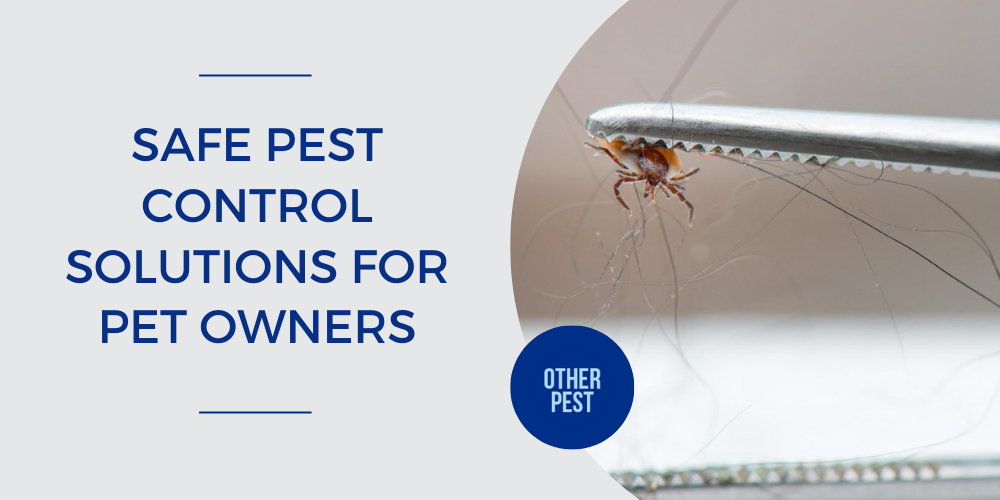Along with the sunshine and blooming flowers spring ushers in, Arizonans also experience increased pest activity. Annoying insects like fleas, ticks, and mosquitoes become more active in the spring because of the warmer weather and it’s the start of their breeding cycles. For many, getting rid of these annoying pests means diligently applying sprays or powders.
However, before taking on DIY pest prevention it’s important to make sure the products being used around the home are safe for children and pets.
In this blog, we will cover effective flea and tick prevention tips and highlight some of the most common chemicals that can harm our four-legged friends.
Send Fleas & Ticks Packing
Maintaining a clean home and yard is the best way to prevent any type of pest infestation. Regularly vacuuming high-traffic areas can remove flea eggs, larvae and other insects before they multiply and become a problem.
It is also a good idea to wash pets’ bedding in hot water weekly to prevent infestation. If you have a yard, keeping the grass short and removing debris such as leaves and wood can reduce places for pests to call home.
Bug & Weed Mart also sells a wide variety of professional-grade DIY products targeted at eliminating fleas and ticks. It’s best to start with applying granule and spray treatments around the perimeter of the home/property.
Products like foggers are effective at clearing out indoor spaces and dry quickly. Bug & Weed Mart also sells products that are applied directly to pets, as well as carpets and furniture.
Other effective and pet-safe pest-control products include:
- Catchmaster Fly Paper
- Eco Defense Home Pest Control Spray
- EcoSmart Home Pest Control
- Summit Mosquito Dunks
Pet-safe home remedies:
- Diatomaceous Earth: This natural powder kills fleas and insects by dehydrating them. Use food-grade diatomaceous earth around high-traffic areas.
- Essential Oils: Oils such as cedarwood and neem naturally repel pests but make sure to always dilute them and to consult your vet before use because certain essential oils can also be toxic to pets.
- Nematodes: Microscopic worms that feed on flea larvae in the soil, reducing infestations safely.
Pesticides and Chemicals to Keep Away from Pets
While pest control is necessary, certain chemicals in some pesticides can pose risks to pets and children. Here are common chemicals to avoid, as well as our recommended alternatives:
Permethrin and Pyrethroids
Found in many insect sprays and yard treatments, these chemicals can cause neurological issues in dogs.
Alternative: Look for natural insect repellents with essential oils such as lemon eucalyptus, cedarwood or neem.
Organophosphates and Carbamates
Commonly found in flea collars and lawn treatments, these can cause vomiting, seizures, and respiratory issues in pets.
Alternative: Use flea preventatives recommended by veterinarians or household cleaners such as Borax or baking soda.
DEET
Deet is a popular ingredient in mosquito repellents for humans, yet it is extremely toxic to cats and dogs.
Alternative: Use pet-safe mosquito repellents with citronella or lavender.
Many common household sprays, insecticides and granules can be toxic to pets when wet, but safe when fully dried. When applying pest or weed control products to an area, be sure to allow sufficient time for the product to dry before giving pets and children access to the area.
Common Drying Times:
Aerosol sprays typically dry within 5 minutes.
Foggers and release sprays dry quickly, within 30 minutes to an hour.
Liquid sprays for indoor and outdoor use can take a few hours to fully dry, depending on humidity and ventilation.
Granules activated with water tend to dry within 2–3 hours
Safe Pest Control Practices for Pet Owners
It is important to know the symptoms and side effects of pet poisoning in order to get quick care. If a pet has been exposed to toxic chemicals from pest control products, there are several symptoms to look out for, including vomiting, excessive thirst, tremors, weakness, difficulty breathing, seizures or diarrhea.
Read Labels Carefully: Always check product labels for pet safety information before using any pesticides.
Allow Sprays to Completely Dry: If using a pesticide inside your home or yard, keep pets away until they are fully dried.
Store Pesticides Securely: Keep pest control products locked in cabinets
Eliminating pests doesn’t mean sacrificing pet safety. By implementing preventative measures, choosing pet-friendly pest control products, and maintaining a clean home and yard, you can effectively protect your furry friends from fleas, ticks, and other pests.
For more information on safe and effective DIY pest control solutions, visit your nearest Bug & Weed Mart. Our team is here to help you keep you educated and your home pest-free while ensuring the safety of your pets and family.
Read :

